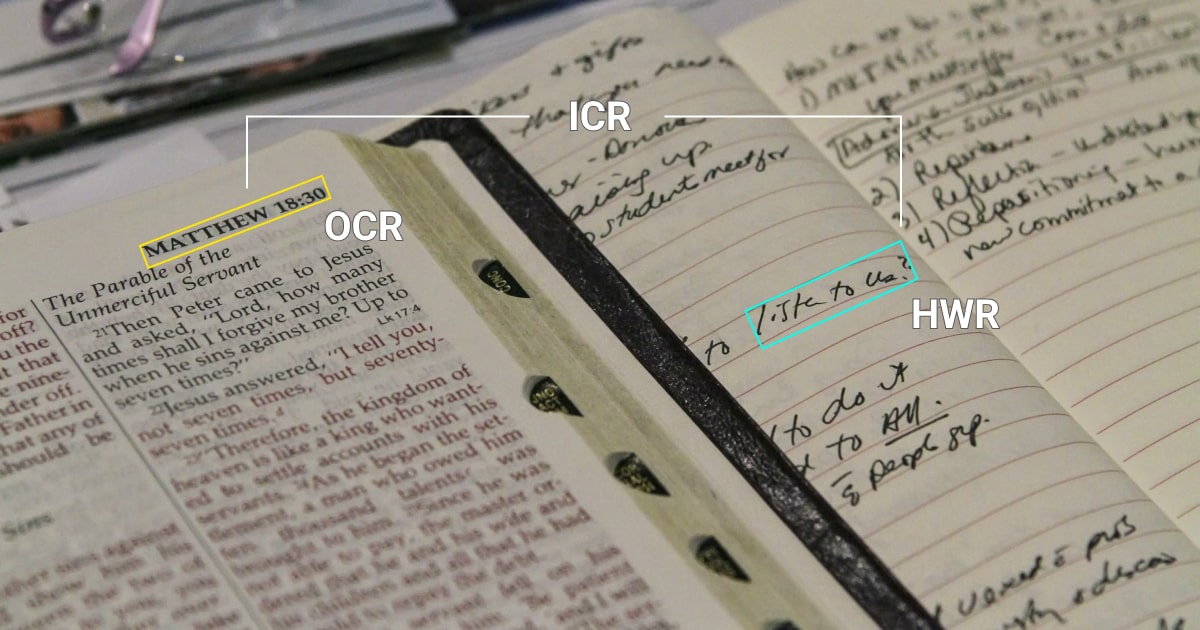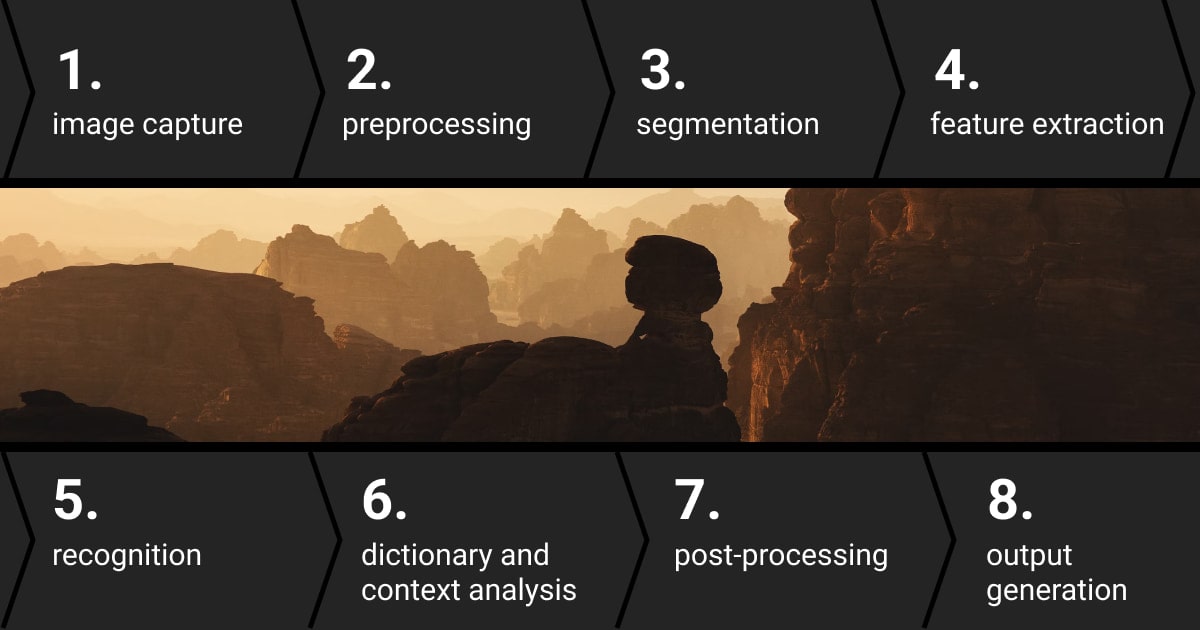- What Is ICR, and How Is It Different from Other AI Recognition Technologies?
- ICR, OCR, HWR: Making Sense of Versatile AI Recognition Technology
In a world dominated by digital devices, there’s something enduringly compelling about the process of putting pen to paper. Despite the convenience of typing, many still find comfort in handwritten notes, whether on traditional paper or digital tablets. This is where Intelligent Character Recognition (ICR) kicks in, bridging the gap between the analog and the digital.
AI-driven recognition seems to have no limits in its progress. Advanced solutions like Optical Character Recognition (OCR), Image Recognition, Facial Recognition, Emotion Recognition, and even Voice Recognition, have taken center stage. From reading medical scans to making self-driving cars smarter, transcribing handwritten notes to identifying faces, the surge in recognition technology enhances AI’s ability to understand images, voices, emotions, gestures, and handwriting.
Today, smart recognition systems are part of our daily routines, showing just how far technology has come. Including ICR, a technology that enables the conversion of handwritten text into machine-readable text. This allows handwritten notes to be seamlessly integrated into the digital realm. In this article, we’ll dive deep into ICR solutions, how they work, their advantages, and real-world applications. Stay tuned!
What Is ICR, and How Is It Different from Other AI Recognition Technologies?

In a nutshell, Intelligent Character Recognition technology, or simply ICR, is a smart tool that can read handwriting from images. Say you take a picture of something written by hand. ICR can understand what’s written on that image and put it into a computer. This is a big step up from regular OCR because ICR uses machine learning to understand different ways and styles people write.
With that said, we can describe ICR as advanced Optical Character Recognition (OCR). Basically, it’s a computer system that takes handwritten characters and turns them into machine-readable information, so that AI could understand it. This technology steps up the game of OCR by handling diverse handwriting styles, ensuring data extraction from both structured and unstructured texts.
ICR technology performs this really well by understanding even messy or unorganized writing. It learns and gets better over time through artificial neural networks (ANNs), adapting and evolving as fresh data is fed into the system, which helps it become even more accurate. First, an ICR system figures out where the words are on a paper (localization), and then it changes those words into text a computer can understand (transcription). This two-step process is how ICR does its magic and enables intelligent document processing for modern business.
That is, for industries immersed in copious forms, letters, and documents daily — think finance, law, and healthcare — ICR is a game-changer. These sectors heavily rely on efficient documentation and expert computer vision services for managing consumer records, patient data, or else, demanding nothing less than 100% accuracy in data capture. And so they need a simple yet powerful tool that mitigates errors while simultaneously saving time and human resources. This is what ICR is all about.
ICR, OCR, HWR: Making Sense of Versatile AI Recognition Technology

Now that we’ve got a handle on what ICR is, let’s take a closer look at it in relation to similar AI recognition technologies.
Intelligent Character Recognition (ICR), Optical Character Recognition (OCR), and Handwriting Recognition (HWR) are all related technologies used to convert images or scanned documents into machine-readable text. However, there are some key differences between them:
Optical Character Recognition (OCR)
OCR technology converts printed or typewritten text from images or scanned documents into machine-encoded text. It is primarily used for printed text recognition and is commonly employed in various applications, such as converting physical documents into editable digital formats (e.g., PDF to Word conversion). OCR with deep learning works well with standard fonts and printed materials, but may struggle with handwritten text or highly stylized fonts. It’s also more affordable compared to ICR.
Handwriting Recognition (HWR)
Handwriting recognition, also known as Handwritten Text Recognition (HTR) or Handwriting OCR, is the process of converting handwritten text or characters into machine-readable text. This technology is more challenging than OCR because handwriting varies greatly from person to person, making it harder to recognize and interpret. HWR systems use complex algorithms and ML techniques to analyze and identify the patterns in handwritten characters.
Intelligent Character Recognition (ICR)
ICR is an advanced form of handwriting recognition that goes beyond simple character recognition. It incorporates complex ML techniques to not only recognize individual characters but also understand the context and structure of the entire document. ICR technology can interpret handwriting in the context of words, sentences, and paragraphs, making them capable of handling complex handwritten documents and forms. Unlike conventional OCR or basic HWR, ICR can provide more accurate and contextually meaningful results.
In summary, the main differences lie in their capabilities and scope:
- OCR focuses on converting printed text from images into machine-encoded text or extracting specific data from that recognized text through OCR data extraction.
- Handwriting recognition deals specifically with recognizing and converting handwritten text into machine-readable form.
- ICR is an advanced version of handwriting recognition that can understand the context and structure of the entire document, providing more meaningful results for complex handwritten documents.
How Does ICR Technology Work?

As we already know, Intelligent Character Recognition (ICR) converts handwritten or printed text into digital characters. The technology specifically focuses on recognizing and interpreting handwritten text, which can be more challenging due to the variations in handwriting styles.
Here’s how ICR technology generally works:
-
Image Capture
The process begins with capturing an image of the handwritten or printed text. This can be achieved by employing either a camera, a scanner, or any alternative device with the capacity to capture images at a high level of quality.
-
Preprocessing
The captured image may contain various imperfections like noise, distortion, and uneven lighting. Preprocessing involves tasks like image enhancement, noise reduction, and normalization to improve the quality of the image and make the subsequent recognition process more accurate. Only qualified data annotation companies offer a suite of additional services to help businesses deal with such data-related tasks.
-
Segmentation
At this stage, the image is divided into individual characters or text blocks. This is particularly important for handwritten text, as different characters might be close together or overlap.
-
Feature Extraction
For each segmented character, various features are extracted to represent its unique characteristics. These features could include aspects like stroke direction, size, curvature, and more. They help distinguish between different characters and improve recognition accuracy.
-
Recognition
The extracted features are then used by ML algorithms, such as neural networks, support vector machines, or hidden Markov models, to classify and recognize the characters. It’s important to train these algorithms on large datasets of handwritten text to learn the patterns and variations in different handwriting styles.
-
Dictionary and Context Analysis
ICR systems often use dictionaries and context analysis to improve recognition accuracy. The system may compare recognized characters with a dictionary to identify possible words. Additionally, analyzing the context of neighboring characters can help correct errors, as certain character combinations might be more likely in a given language.
-
Post-processing
Once characters are recognized, there might be errors in the output due to the inherent complexities of handwriting. Post-processing techniques, such as error correction algorithms and language modeling, can be applied to refine the recognized text.
-
Output Generation
The final output of the ICR system is the converted digital text. This text can be further processed, stored, searched, or analyzed just like any other digital text data.
Overall, the accuracy of Intelligent Character Recognition technology can vary based on factors like handwriting quality, the language being recognized, the complexity of the content, and the quality of the image captured. Thus, the ICR system must be trained on diverse and representative data for achieving higher accuracy rates.
Many ICR software programs come with a self-learning feature known as neural networks. These networks continuously update their recognition database to identify new styles of handwriting. So, when the ICR encounters a handwriting style it doesn’t recognize, it improves by adding it to its database. With each new dataset, the neural network’s learning improves, making its handwriting recognition more accurate. However, sometimes messy handwriting might lead to lower accuracy, yet structured handwriting can achieve over 97% accuracy.
The ICR system’s process can be broken down into three simple steps:
- ICR scanning and capturing digital handwriting content.
- Breaking down each letter and number into smaller segments, matching them with neural network data. If the handwriting isn’t recognized, the ICR software learns it and updates the network.
- Converting the content into a well-structured digital format that anyone can easily grasp.
Top 10 Real-World Applications of Intelligent Character Recognition
Intelligent Character Recognition (ICR) has revolutionized document processing (IDP) across industries. Its advanced capabilities enable the extraction of meaningful data from complex documents, helping businesses with the following tasks, such as:
- Financial Processing: Streamlines invoices, receipts, and automates check processing systems, reducing errors and boosting efficiency.
- Healthcare Records: Digitizes patient records for faster retrieval and better care.
- Form Automation: Extracts data from forms and surveys, saving time and improving analysis.
- Logistics: Accelerates processing of shipping documents, enhancing tracking accuracy.
- Legal Analysis: Swiftly scans and analyzes legal documents for research and case preparation.
- Mailing Systems: Reads handwritten addresses on envelopes, improving sorting accuracy.
- Education Enhancement: Manages student records, automates grading, and digitizes materials.
- Retail Operations: Digitizes product descriptions, processes feedback, and returns.
- Government Records: Digitizes citizen records, application forms, and historical documents.
- Automotive: Processes handwritten data on production forms, upholding manufacturing standards.
As you can see, AI recognition technologies, including ICR, continue to reshape how we manage textual information across sectors, with more innovations on the horizon.
Why Ignoring Intelligent Character Recognition (ICR) is Not a Viable Business Strategy?
Businesses often grapple with the burden of processing handwritten forms, a task that consumes valuable time, resources, and demands manual data entry. ICR steps in to automate this process, swiftly converting handwritten content into digital, searchable formats, mitigating efforts. The next challenge is managing a diverse vendor network, especially with some suppliers relying on paper documentation. Embracing ICR facilitates seamless transition by rapidly digitizing paper-based invoices and receipts, ensuring timely and accurate data integration.
Besides, document scanning, while convenient, frequently falls short when it comes to searchability within files. Through ICR and OCR online software, organizations can unlock the ability to swiftly locate essential information within digitized documents, enhancing productivity. The technology also revolutionizes document management, allowing to easily catalog, arrange, and access digital files, promoting adaptability and intelligence within organizations.
Last but not least, inclusivity matters. ICR addresses this by offering assistive solutions to employees and customers with visual impairments, making data accessible through specialized software. Finally, the shift to remote work is accelerated as Intelligent Character Recognition transforms paper documents into digital formats. This eliminates the need for physical storage, granting secure remote access to essential documents, bolstering business continuity regardless of location.
Summary

There are timeless reasons why manual note-taking remains a steadfast choice in our technologically advanced era. However, the advent of Intelligent Character Recognition has bridged the gap between traditional methods and modern convenience.
In this article, we’ve aimed to explain the comprehensive ICR meaning across diverse industries and its many applications for businesses. As discussed, ICR’s remarkable ability to accurately convert handwritten or printed text into digital formats, as well as comprehend different fonts and styles, has revolutionized industries reliant on data management and accessibility.
ICR can be a demanding process, but you can rest easy knowing we’ll handle it all. At Label Your Data, data annotation for OCR and similar tasks is among our expertise.
Reach out to us for expert document annotation to train your OCR, ICR, or HWR algorithm!
FAQ
What does ICR stand for in automation?
The ICR meaning in automation is Intelligent Character Recognition. Using advanced ML algorithms, this technology accurately interprets and converts handwritten or printed characters into digital text, reducing the need for manual data entry in various automated processes.
What is the difference between OCR and ICR technology?
Unlike ICR, OCR technology primarily focuses on converting printed or typewritten text into machine-readable text, whereas ICR is a type of OCR that extends this capability to handwritten characters. This way, ICR software can interpret and process both printed and handwritten content, including different fonts and styles.
What are the key features and benefits of using ICR software in business?
ICR software in business provides efficient automation by accurately converting handwritten and printed characters into digital text, streamlining data entry processes and enhancing overall operational productivity.
Table of Contents
Get Notified ⤵
Receive weekly email each time we publish something new:

